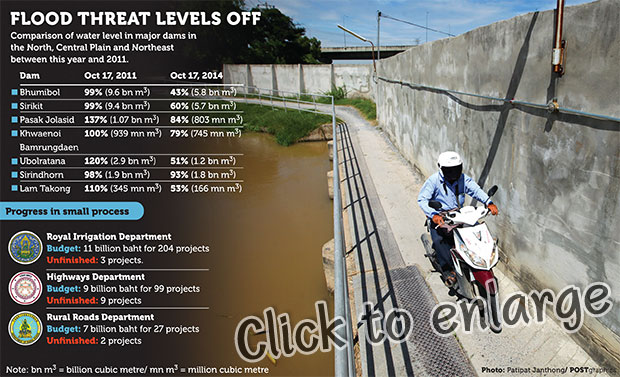There are few safeguards against a repeat of the 2011 disaster
Little tangible progress has been made on the water management projects started by the previous government after the devastating floods of 2011.
Little tangible progress has been made on the water management projects started by the previous government after the devastating floods of 2011.
The past government launched projects to deal with both floods and droughts but little has been accomplished, thanks to what experts say is a combination of protest action by residents, lack of research into the projects, and the way the megaprojects were bundled together, making work on individual components hard to achieve.
Thailand is now in a transition from the wet season to the dry season. People in towns, particularly those who experienced the floods when they hit three years ago, are worried they might recur. Farmers, meanwhile, fear the recurrence of serious drought.
After the 2011 floods, the Yingluck Shinawatra administration came up with ambitious water management projects worth 350 billion baht.
The projects comprised nine construction modules, including large floodways, flood barriers, reservoirs, and a data management system.
Bidding for the work was done, and the construction contractors chosen. However, the 350-billion-baht scheme hit a snag at the public hearings stage.
Residents who stood to be affected by the projects disrupted the meetings, which forced progress to a halt.
The scheme lost momentum after the House dissolution in December last year and was suspended after the May 22 coup.
Prime Minister Prayut Chan-o-cha asked state agencies to draft a national water management plan to replace the 350 billion-baht scheme.
However, several projects launched under the Yingluck government initiative are expected to be included in the plan.
“We don’t have new tools for water management, despite the fact three years have passed since the flood disaster,” said Suwatana Chittaladakorn, a water management expert and adviser to the Water Management and Policy Committee (WMPC).
Since the past government integrated water management construction projects into nine modules, some projects which were ready to go could not be proceeded with separately, even when they did not run into protest action, he said.
As a result, authorities should make the most of what they have, including improving the capacity of canals, rivers and sluice gates.
The main concern for this year has turned to the risk of droughts, which may turn out to be more serious than last year since water storage in major dams in the Chao Phraya and Mae Klong River basins remain low.
In 2012, authorities released water from the major dams, which sat at just 20% of capacity, amid fears the floods of 2011 could recur.
That had caused problems in the water supply which still persist.
Pramote Maiklad, former director-general of the Royal Irrigation Department, said Thailand’s water management system has yet to improve despite the flood disaster of 2011.
The Yingluck government’s attempt to develop ambitious projects failed because it was in too much of a hurry and did not study the projects thoroughly.
Encroachment into waterways, and town expansion without suitable town planning safeguards, were among key reasons for the heavy floods of that year.
Solving these problems was no less important than investment in the megaprojects, he said.
Lertviroj Kowattana, director general of the Royal Irrigation Department, said the department had received an 11-billion-baht budget to repair water management hardware such as floodwalls, sluice gates, water pumping stations, and waterways.
He said more than 95% of the projects have been completed.
“We have made a lot of progress but a few projects have been held back by land disputes,” he said.
However, he accepted those tools were still far from what was needed to cope with a flood if the amount of water flowing in the rivers was as high as that of 2011.
He said the drought situation was a big concern this year since a lot of the water supply in dams was released to tackle the drought last year.
In addition, off-season rice crops have expanded to 900,000 rai this year, exceeding the target of 470,000 rai.
The Highways Department received a budget of nine billion baht to develop flood management projects after the 2011 flood.
Its projects include lifting road levels to serve as flood barriers for a total length of 300 kilometres in Ayutthaya, Samut Prakan, Bangkok, Pathum Thani, and Nonthaburi provinces.
Some 91 road-lifting projects with a budget of 8.4 billion baht have been completed.
Other projects with a budget of 600 million baht involved strengthening river bridge pillars.
The Department of Rural Roads received 7 billion baht to lift road levels and build up sheet piles along river banks with a total length of 360 kilometres, including roads surrounding flood-hit industrial estates in Ayutthaya.
Meanwhile, the Office of the Auditor-General in July released a probe report which found 290 million baht of the department’s budget was allocated to places which faced no flood risks at all.
It surveyed 137 routes in 21 provinces and found that 21 routes were not affected by floods.
Source: http://www.bangkokpost.com/news/environment/438532/flood-projects-run-aground



